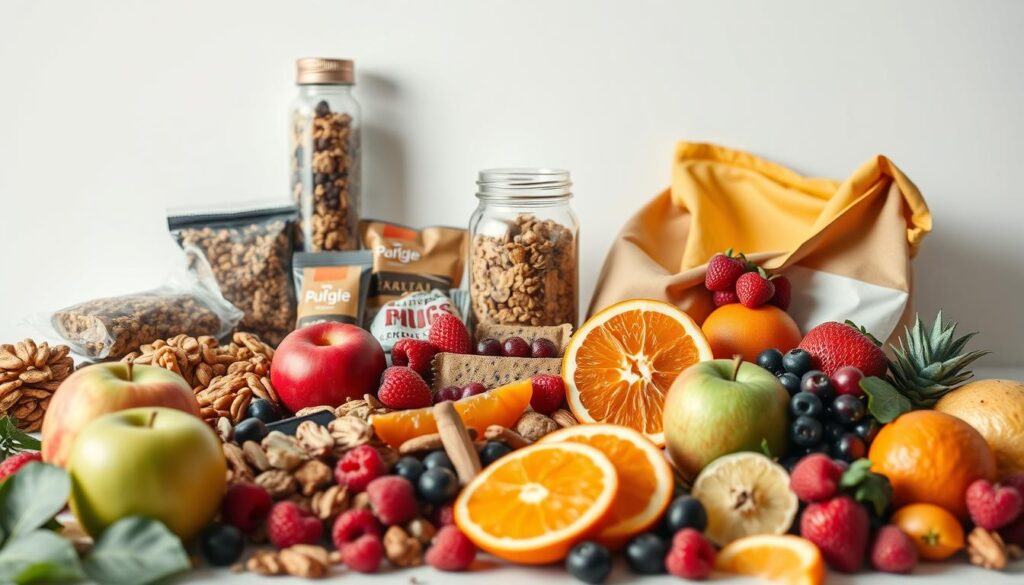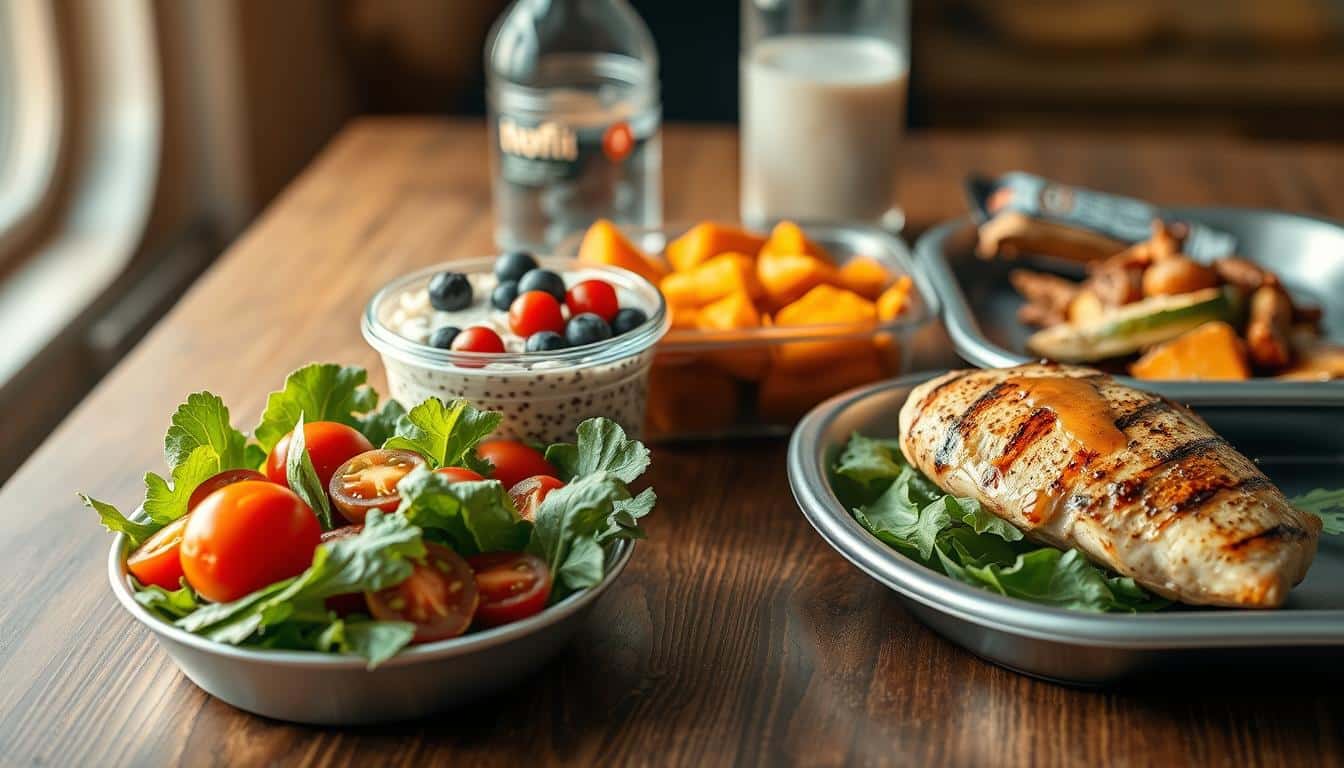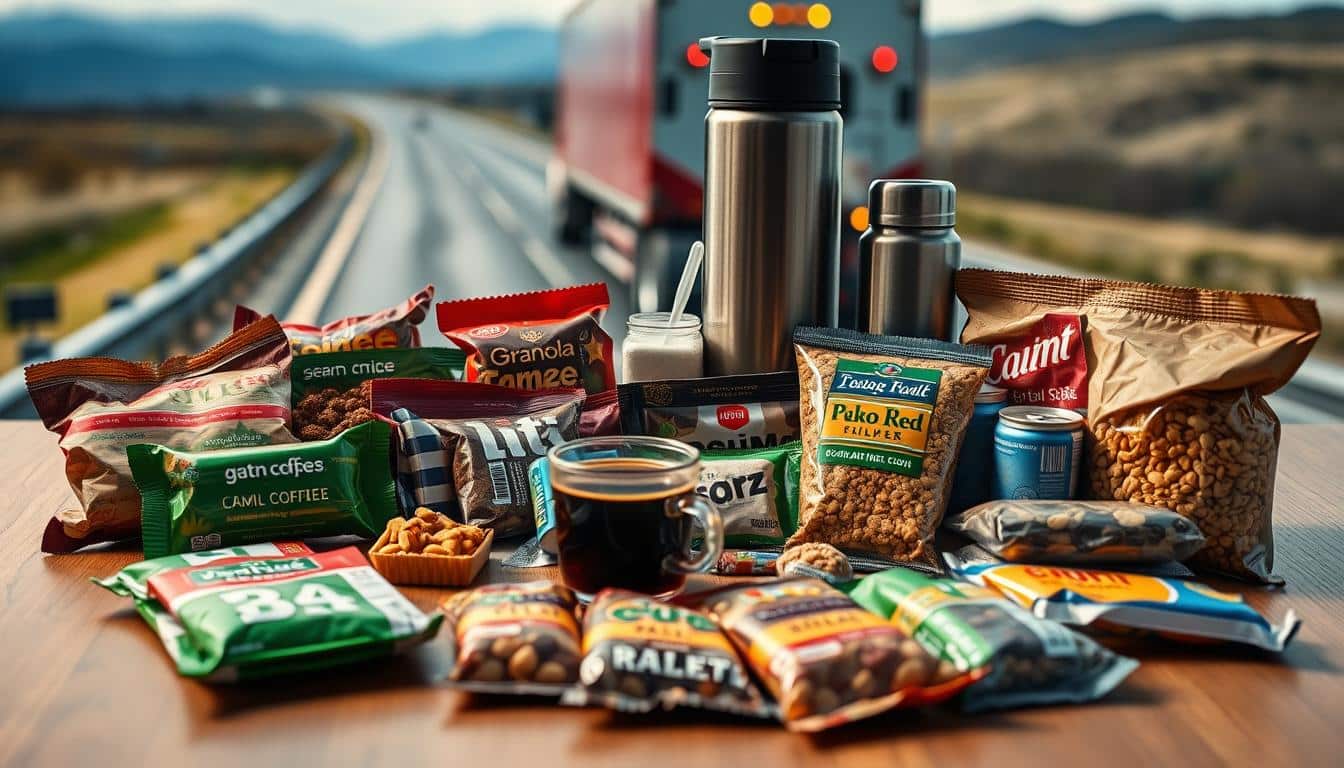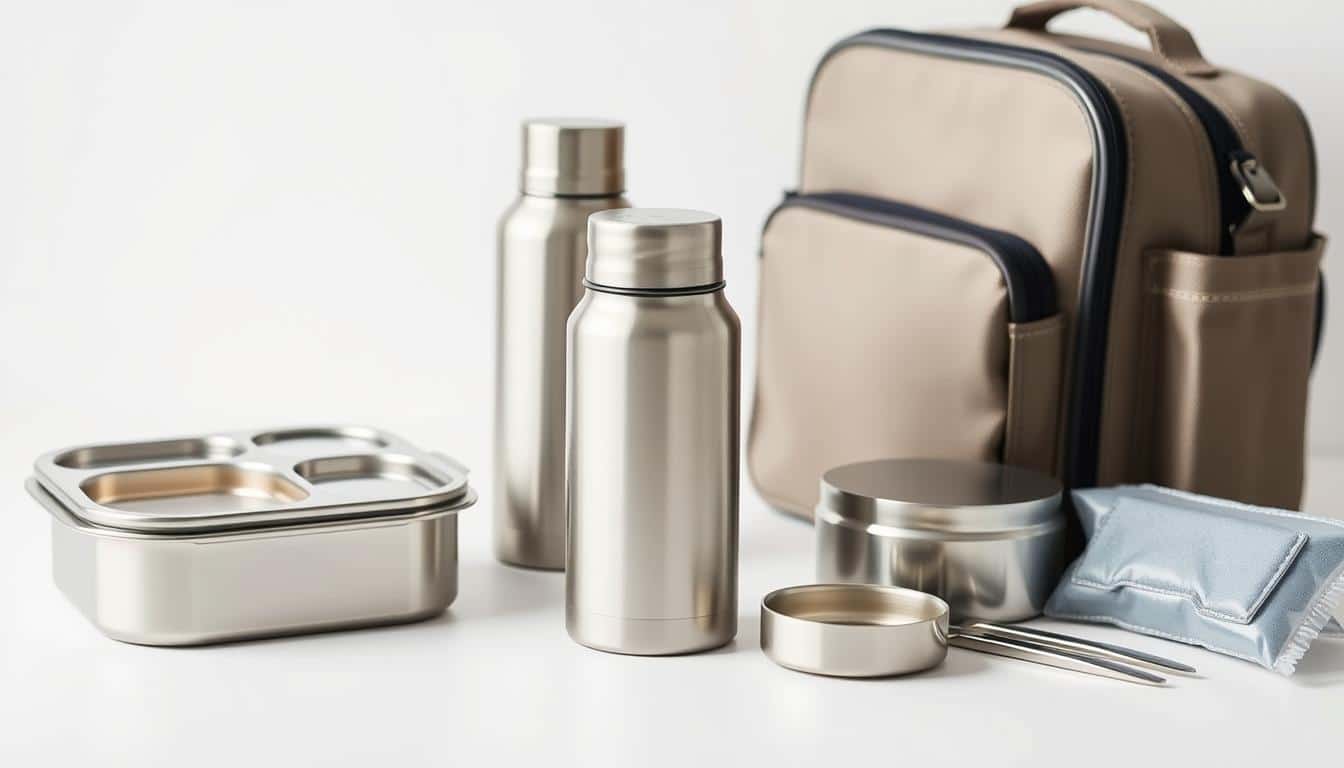Meal planning helps you make thoughtful choices instead of rushed decisions. It’s a great way to save time, cut expenses, and eat healthier. This is true whether you’re on a commute, traveling, or managing a hectic schedule.
Begin by setting achievable goals. Focus on prepping fundamentals like grains, veggies, and proteins. These can be easily combined into various meals. Such prep work reduces unnecessary spending and gives you more free time, perhaps for a workout.
Believing you’re a healthy eater can actually help you follow through on your meal plans. This is particularly true when considering meals and snacks for travel. Using simple tools like reusable containers and snack-size packs can make healthy eating stress-free.
When planning your weekend prep, think about ingredients that can be repurposed in multiple meals. This keeps things interesting. To keep salads and boiled eggs fresh, use airtight containers with a damp paper towel. Always store sauces separately for the best taste when reheated.
Why on-the-go meal planning saves time, money, and stress
Planning meals for on-the-go helps make busy days less stressful. Prepping on weekends and choosing theme nights can simplify daily decisions. This makes it easy to see why meal planning is good for mixing things up, staying healthy, and making life easier.
Evidence-based benefits of planning meals
Research tells us that people who plan meals eat a better variety of foods. They also consistently get the nutrients they need compared to those who don’t plan. In a six-week study, people who planned their meals cut their cooking time significantly each week.
Using tricks like chopping veggies just once, writing shopping lists, and stocking the freezer saves prep time. These strategies especially help during the busy weekdays.
Decision fatigue and reduced stress
Brouwer and Mosack’s studies show seeing yourself as a healthy eater leads to better food choices. This identity makes it easier to choose prepared meals over fast food, especially when you’re out or working late. Meal planning also reduces how much we have to decide daily, freeing up our minds for work and family time.
Real-world savings from a week-long experiment
Cox found that planning meals for a week led to spending less money on groceries. The savings were about £40 compared to regular shopping habits. Having meals ready also reduced unplanned purchases on the way home, cutting food costs by reducing waste.
- Save time with meal prep by batching tasks and using leftovers.
- Reduce food costs through smarter shopping and fewer impulse purchases.
- Decision fatigue meal planning frees mental space and lowers stress.
Plan with cross-over ingredients to minimize waste and cost
Smart shopping and simple swaps make a small list go far. Use versatile items to cut down on food waste and save money. This method is great for budget-friendly planning and keeps meals interesting with little effort.
What cross-over ingredients are and why they matter
Cross-over ingredients are things like canned tomatoes or roasted sweet potatoes that you use in many meals. Mimi Harrison says making a shopping list with these items reduces waste and stretches your dollars.
Sample ingredient pairings for on-the-go meals
- Roasted sweet potatoes: serve whole with rice bowls, puree into soup, or mash into wraps.
- Tomato sauce: base for pasta, pitta pizzas, or a quick stew with canned beans and tuna pouches.
- Cooked grains + canned beans + a roasted veg: mix for salads, bowls, or fillings for tortillas.
- Frozen mixed vegetables + shredded chicken: toss with noodles, add to omelets, or reheat as a side.
Shopping-list strategy for fewer items, more meals
- Check the pantry first to ensure you don’t buy what you already have.
- Focus on multi-use items like canned beans and whole-grain crackers for travel and quick eats.
- Buy fresh veggies that work in several meals. Cox suggests using courgette in different ways to avoid waste.
- Plan theme nights to make choosing ingredients easier and cooking quicker.
Keeping your list short saves time and reduces extra trips to the store. By choosing carefully, you can enjoy a variety of meals without spending a lot.
Build versatile bases so meals don’t feel repetitive
Start by choosing a few flexible ingredients. This lets you swap flavors without more work. Include things like cooked grains, simple proteins, a tasty sauce, and greens. This approach helps you mix things up and keep dinners exciting.
Concept of bases: grains, sauces, proteins, and greens
Use cooked rice, quinoa, or couscous as a base for your meals. Add proteins like roasted chicken, tuna, or beans. Have tomato sauce and pesto ready for easy flavor changes.
Greens can be mixed salad or spinach. They add crunch and health benefits. Use citrus, herbs, and spices to switch up the flavors without needing new recipes.
Transforming one base into multiple meals
Imagine using quinoa for three different dinners. First, make a Mediterranean bowl with olives, feta, and lemon. The next day, combine quinoa with chicken, greens, and pesto. Then, create a quick stew with quinoa, tomato sauce, and beans.
- Theme nights like Mexican, Mediterranean, or Asian change up the grain’s feel.
- Reuse roast in salads, sandwiches, or soups for more variety.
- For travel, bring wraps, pre-cooked rice, and yogurt for easy meals on the go.
By cooking bases in bulk, you save on prep time and increase your options. Switch toppings, try a new sauce, and add fresh greens. This keeps meals interesting and simplifies meal planning.
Efficient meal-prep day strategies and realistic time planning
Start meal prep with a plan. Know your appliances, time needed, and who will help. Surprises will happen. Cox thought it would take three hours but took nine due to limited oven space and containers. Always include extra time in your plan to avoid stress and food waste.

Consider your kitchen setup like a mini production line. Have ingredients out, containers labeled, and utensils ready at each station. Organize tasks by appliance to minimize walking around too much.
Plan realistically for appliances, hands-on time, and helpers
- Make a list of every appliance you’ll use: oven, stove, slow cooker, blender. Remember, each has its own space limit.
- Figure out how much time you’ll actually be working on each recipe. Then double it for any interruptions.
- Let helpers do easy jobs: washing, cutting, or packing. Even kids can help by labeling containers.
Staging and oven management tips
Follow a staging sequence: start with dry goods, then move to produce and proteins, and set up cooking stations last. This strategy minimizes the need to setup and clean repeatedly. Cut your vegetables all at once to use in several dishes.
Match oven recipes by temperature to cook multiple items together. Use racks and sheet pans wisely. Rotate them for even cooking. Plan your baking sequence well to keep your oven busy.
Divide tasks and use short-cuts to reduce total hours
- Focus on tasks that save the most time first. Prepare grains in batches, roast lots of veggies, and make a versatile protein.
- Go for time-savers like frozen veggies, canned beans, and quick-cook grains. These don’t hurt the meal’s healthiness.
- Keep timers handy and take short breaks to stay fresh. Clean as you go. Have a plan for washing dishes to avoid delays.
For meals on the go, use reusable containers with labels showing dates. Pack them in a cooler with ice packs to stay fresh. These steps can make your meal prep smooth and something you can do again and again.
Smart storage and packaging for freshness and portability
Good storage makes prepping for a week simple. Keep hot and cold items apart. Label each container and organize fridge and freezer portions. This keeps meals fresh and reduces waste.
Airtight containers from brands like Pyrex or Rubbermaid help food last longer. Put a damp paper towel in containers with greens or eggs to keep them crisp. Divide meals into single portions for easy, healthy eating.
- Choose clear containers so you can see contents and avoid duplicate purchases.
- Label freezer portions with dates and rotate them within six months to maintain quality.
- Keep snacks in a small “kitchen drive-thru” bin for quick mornings.
Fridge vs. freezer: what to store where and when
Store meals in the freezer if you won’t eat them soon. Keep food for the next few days in the fridge. Don’t mix sauces and carbs to keep meals tasty. Use special fridge containers for cut veggies and fruits to keep them from spoiling.
- Cook large batches, portion them, and freeze half for later.
- Keep ready-to-eat salads in the fridge and dress just before eating.
- Mark items with prep dates to make rotation easy.
Keeping salads and snacks fresh
Put dressing in a separate container to keep salads fresh. Use a damp paper towel on leafy greens to keep them crisp. Pack single-serve hummus, yogurt, and sealed snacks to avoid waste.
For trips, ask for a mini-fridge and use insulated containers and ice packs. Portable, locking containers keep your food safe on the go.
Packable meal and snack ideas for travel, work, and busy days
Travel days and long work hours need simple and reliable food choices. Here are some quick-to-prepare or long-lasting meal ideas. They balance flavor, health, and convenience, so you can focus on your day, not on food.

- Dry instant oats mixed with flax seed, dried fruit, and nuts. Use a hotel coffee-maker or kettle for hot water to make quick oats on the go. These packable breakfasts store well and warm up fast.
- Hard-boiled eggs with whole-grain toast or a piece of fruit. Eggs stay good in a mini-fridge or insulated cooler for a day.
- Single-serve yogurt or cottage cheese with granola or berries. Put them in small containers for an easy snack or breakfast.
Lunches and dinners for commuting and travel
- Whole-grain bread, tortillas, or crackers with cheese and turkey, peanut butter, or tuna and salmon pouches. These portable lunches need little refrigeration.
- Pre-portioned beans or legumes with avocado slices and salsa. Keep the avocado fresh in a cooler bag till afternoon.
- Freeze single servings of soups, stews, or chili. Thaw them in a microwave or hot water for fast dinners or emergency meals.
- Turn last night’s leftovers into wraps, salads, or sandwich fillings. This adds variety and reduces waste.
Healthy snack packs and emergency meals
- Homemade trail mix with nuts, seeds, and dried fruit. Portion them into single-serve bags for on-the-go healthy snacks.
- Pre-cut veggies with single-serve hummus cups and whole fruit like apples or grapes. These are great for quick energy boosts.
- Stock a grab-and-go bin with bars, individual nut packs, microwave soups, and kombucha. It makes assembling emergency meals easy when your plans change.
- Freeze individual dinners or grains for quick options. They reheat well in a hotel microwave or office kitchen.
When you can, use a mini-fridge for yogurt, string cheese, edamame, and hard-boiled eggs. Mark containers with dates and rotate them weekly. Just a few basics and some planning let you have ready-to-eat meals and snacks anytime, anywhere, without hassle.
On-the-go meal planning for travel and hotel stays
Planning meals for travel changes a hotel stay or long drive. It lets you enjoy fresh, tasty food. Simply pack some essentials, request basic room amenities, and choose your stops wisely to avoid hunger-based decisions.
Bring reusable containers, cutlery, a blender, and a can opener. This makes more options possible, even with limited space. In hotels, get a mini-fridge and microwave. Keep snacks like yogurt, salad greens, and boiled eggs fresh. Use the microwave for quick meals like oatmeal or baked potatoes.
Make a small kit with your favorite spices and sauces. This adds flavor without needing a full kitchen. Choose versatile items like wraps and canned beans for easy meals. Have snacks and backup meals ready to avoid buying expensive food on the go.
- Pack essential items: canned tuna, beans, and grains for quick, healthy meals.
- Use a cooler with ice packs to keep food fresh on long trips.
- Bring frozen or chilled foods that last for a couple of days for variety.
Begin with planning your route for road trips. Look up restaurants and grocery stores along the way. Choose places with known nutritional info for consistent meals. Plan stops at healthier places to avoid unhealthy, impromptu eating.
For longer journeys, mix convenience with nutrition. Pack meals in layers, like jar salads or grain bowls. This keeps eating varied and healthy with minimal effort. A little planning saves money, reduces waste, and maintains your energy while traveling.
Meal-planning systems and tools for busy lifestyles
Set up simple steps that make weekday meals easy. Begin with a weekly list of favorite meals, nights out, and planned events. Use theme nights, like Taco Night or Meatless Monday, to make choosing and preparing faster.
Weekly routines
- On Sunday, list your family’s favorite dishes and ask for their ideas.
- Put the plan on a whiteboard or chalkboard to remember each day.
- Use menus that work well again to make planning automatic.
Pantry organization and ready kits
- Organize the pantry by type: baking, canned goods, snacks, grains.
- Keep things in clear, sealed containers to see what you have easily.
- Put together kits for tacos, sandwiches, and breakfast for quick meals.
- Have bins ready for fast breakfasts and lunches.
Apps, lists, and visual planners
- Meal planning apps can save recipes, make shopping lists, and sync with calendars.
- When traveling, find dining spots in advance and track nutritional info from popular chains.
- Use reusable containers and keep a list for stocking hotel or cooler snacks.
Combine lists for shopping for versatile ingredients with prepped portions for easy use. This makes meal planning doable, helps with weekly meals, improves pantry setup, and works well with meal planning apps for busy schedules.
Maintain flexibility and avoid meal-prep burnout
Meal prep is best when it fits into your lifestyle, not the other way around. Aim for a system that is helpful and easy to adjust. Being flexible means you can change plans when unexpected events happen.
Don’t prep every single meal
Prepping all your meals can make you tired of your food. I talked to a home cook, Cox, who got fed up after doing too much meal prep. Instead, experts suggest leaving room for meals that come up on the spur of the moment. Plan two or three dinners, but also keep some meals open for going out or something quick and fresh.
Rotate prepped items and plan for flavor evolution
Changing up your meals keeps things interesting. Use the same ingredients, like grains and roasted veggies, in different meals. Plan for meals that get better over time, like stews and curries, while eating the more sensitive dishes earlier in the week.
Rotating your dishes keeps your menu exciting. Have backups like frozen pizza or microwave meals ready for emergencies. This way, you won’t feel stuck with your meal plan.
Include planned treats and social flexibility
Add some fun to your meal plan with treats. For instance, a piece of dark chocolate can make your snack time something to look forward to. Embrace a balanced identity that allows for meals out with friends sometimes.
Plan for nights off to make meal planning easier to stick with. If an outing comes up, enjoy it guilt-free and then get back to your usual meals. This approach eases stress and helps you keep going without burning out on meal prep.
Conclusion
This summary shares lessons from a week-long meal planning trial. It shows that planning helps save time, cut costs, and make better meals. However, it also highlights common mistakes like underestimating how long it takes to prepare, running out of containers, and not having enough oven space.
The key lesson is to find a balance. It’s helpful to prepare breakfasts ahead, make some meals for the freezer, and use ingredients in different ways. This approach cuts down on waste and keeps meals interesting.
Embracing a healthy-eating lifestyle makes it easier to maintain good eating habits, even when busy or traveling. Packing light cooking tools and using what hotels offer can help. Bringing along basic foods and spices means you can still eat well without too much luggage.
Planning where to eat before traveling and having a go-to kit for meals can make eating well easier. This way, being away from home won’t stop you from enjoying healthy meals.
Having a system for meal prep fits well with busy American lives. Ideas like having a theme for each night, prepping vegetables just once, organizing the pantry, and keeping the freezer stocked can make evenings smoother. It’s about planning ahead, using storage wisely, and changing up flavors to keep meals fresh and exciting.
By following these strategies, you can save time and money. Plus, it helps reduce stress. This makes enjoying tasty, ready-to-go meals easier, supporting a busy lifestyle.
FAQ
Why does on-the-go meal planning save time, money, and stress?
What evidence supports the benefits of meal planning?
How does meal planning reduce decision fatigue and stress?
What are cross-over ingredients and why do they matter?
Can you give sample ingredient pairings for on-the-go meals?
What shopping-list strategy cuts items but creates more meals?
What is a versatile base and how does it prevent boredom?
How do I transform one base into multiple meals?
How should I plan realistically for meal-prep day timing and appliances?
What staging and oven management tips speed up prep?
How can I divide tasks and use short-cuts to cut total hours?
What containers and labeling practices keep meals fresh and portable?
What should I store in the fridge versus the freezer, and when?
How do I keep salads and snacks fresh for the week?
What breakfasts travel well for busy days or flights?
What lunches and dinners work best for commuting or travel?
Which healthy snacks and emergency meals should I prepare?
How can I use hotel amenities to expand meal choices when traveling?
What gear and packing tips help on longer trips or road travel?
How do I research dining options for travel to stay on track?
What weekly routines and tools make meal planning stick for busy lives?
How do pantry zones and ready-to-grab kits speed up mornings?
Which apps and visual planners help manage on-the-go meal systems?
Should I prep every single meal each week?
How do I rotate prepped items and plan for flavor evolution?
How can I include treats and social flexibility without derailing planning?
What are common meal-prep pitfalls and how do I avoid them?
How do I plan for snacks and emergency meals so I don’t binge or shop impulsively?
Content created with the help of Artificial Intelligence.



